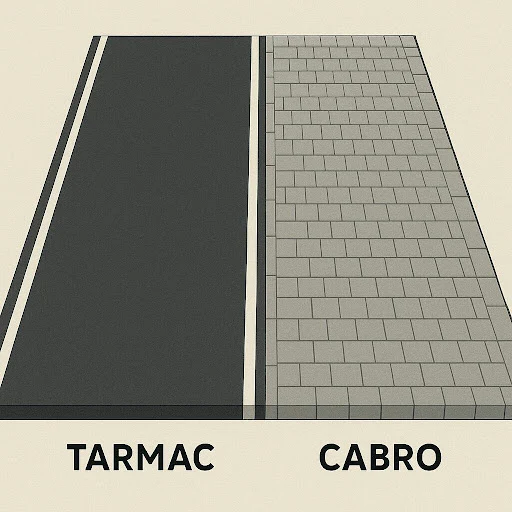On August 18th, Kagio town’s roads project kicked off where it was launched by GK promising a transformative upgrade for many of Kagio’s busiest and most degraded streets. With Ksh100 million earmarked for the work, the project is already delivering visible change and not just in graded surfaces and construction equipment but in the rising expectations and debates among residents about what the final product will look like.
To understand why the debate matters, one must consider the differences between tarmac (asphalt) and cabros. Tarmac typically costs less per square metre to lay down, is quicker to install and provides smoother driving surfaces. In many parts of Kenya, it is preferred for roads that carry heavy traffic especially vehicles like minibuses, articulated lorries and for areas prone to erosion or heavy rainfall. On the other hand, cabros are decorative, easier to replace for small patches and sometimes more aesthetically pleasing especially for pedestrian‐friendly zones. But they come with downsides: they may shift under heavy weight, allow weeds between blocks, can be more labour intensive to install and sometimes cost more in long‐term maintenance.
Some UK paving research, for example, shows that block paving (similar to cabros) offers versatility in design and a pleasant visual finish but tarmac tends to win in cost efficiency and easier upkeep. These trade‑offs are being weighed by many Kagio residents, some of whom argue that using cheap materials now could mean paying more later in repairs and maintenance.
Since the launch, construction has proceeded at a steady pace. Early mornings and late afternoons now echo with the rumble of earthmoving machinery, while roads once impassable during rainy spells are slowly being reshaped. Graders, compactors and drainage crews are working across several interchange points in the town. The sites are busier and despite occasional inconveniences, dust, detours and noise, most residents seem satisfied that progress is real and happening in full view.
But among the excitement lurks uncertainty. Many people in Kagio are blanketed by questions: Will these roads be tarmacked or will they be paved with cabros (block paving)? That uncertainty has become a central topic in local discussions and daily conversations in hotels and markets. It seems the project announcement did not clearly specify the surfacing material leaving room for rumors, hopes and some disappointment.
Local voices are now calling for clarification. “I hear contractors are laying cabros, others say bitumen. Which roads will get which finish? We deserve to know,” said one boda boda operator waiting near the grading works. For shop owners whose businesses line the roads in question, the uncertainty matters: smooth tarmac can mean less dust, cleaner entrances and fewer puddles. Cabros might offer visual appeal but could make sweeping daily chores harder if gaps collect debris or allow water seepage.
The project’s funds are substantial and thus expectations are high. Residents note that if GK had announced precisely which roads would be surfaced with tarmac vs cabro, many worries would be eased. Some expect that major arterial roads would be tarmacked due to traffic load while smaller residential roads or sidewalks might receive cabro treatment. But for that to happen well, proper drainage, strong base layers and quality materials are essential. Poor foundation work or lack of drainage can quickly degrade either surface especially during heavy rains.
Technical concerns also feature in the discussions. Tarmac, for example, requires bitumen, aggregate, proper compaction and heat application. Factors that demand experienced contractors, good quality control and ongoing maintenance. Cabros, while simpler in some aspects, need solid edging, proper leveling, sand bedding and attention to how water moves off the blocks. Without good workmanship, both will suffer. Many residents stress that the quality of workmanship is more than just the choice of material that will determine whether these roads are a legacy of development or soon face potholes and erosion.
Meanwhile, early photos of the construction show machines leveling and preparing earth surfaces, trenches for drainage and a few test patches. Some sections already show compacted gravel and initial foundation layering. But no distinct signs yet of hot mix asphalt being laid, nor clear cabro block laying visible publicly. The lack of visible surfacing material has fueled speculation that contractors might be waiting to establish firm groundwork before choosing based on road usage, budget and perhaps weather.
As Kagio residents wait, many are hopeful. Parents worry less about pupils walking through muddy or flooded sections, business owners look forward to easier transport and cleaner shop fronts and boda boda riders anticipate smoother rides and fewer breakdowns. The promise of a road network that improves daily life is powerful whether the final surface is sleek blacktop or patterned cabro blocks.
In a town building its reputation as a growing hub in Kirinyaga, this project under GK’s watch could be a turning point. If done right, with clarity, durable materials, proper drainage and transparent communication about which roads will be tarmacked vs paved with cabro, Kagio could set a standard for infrastructure development in nearby towns. The question remains: will the finish match the ground that’s already being laid?

